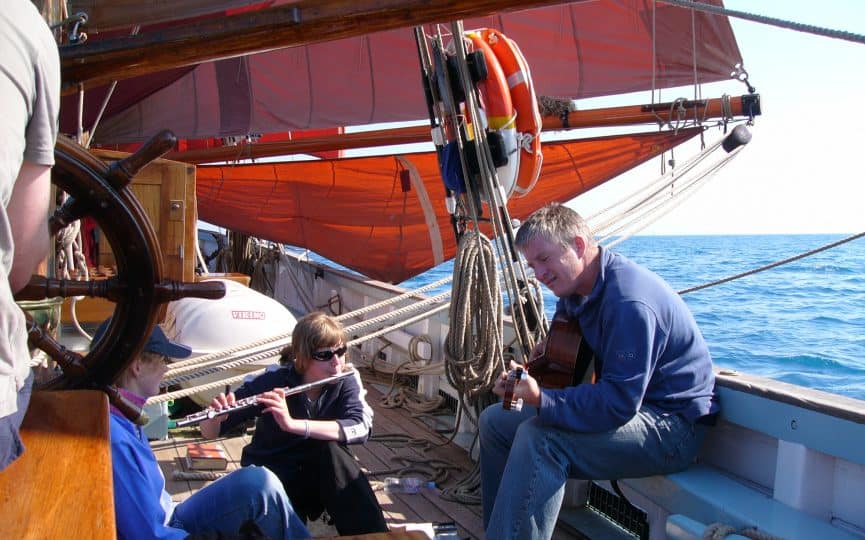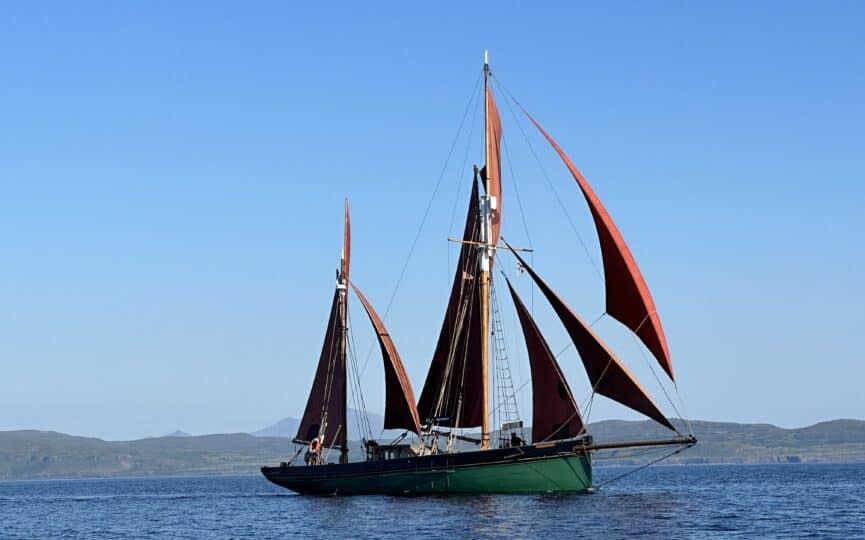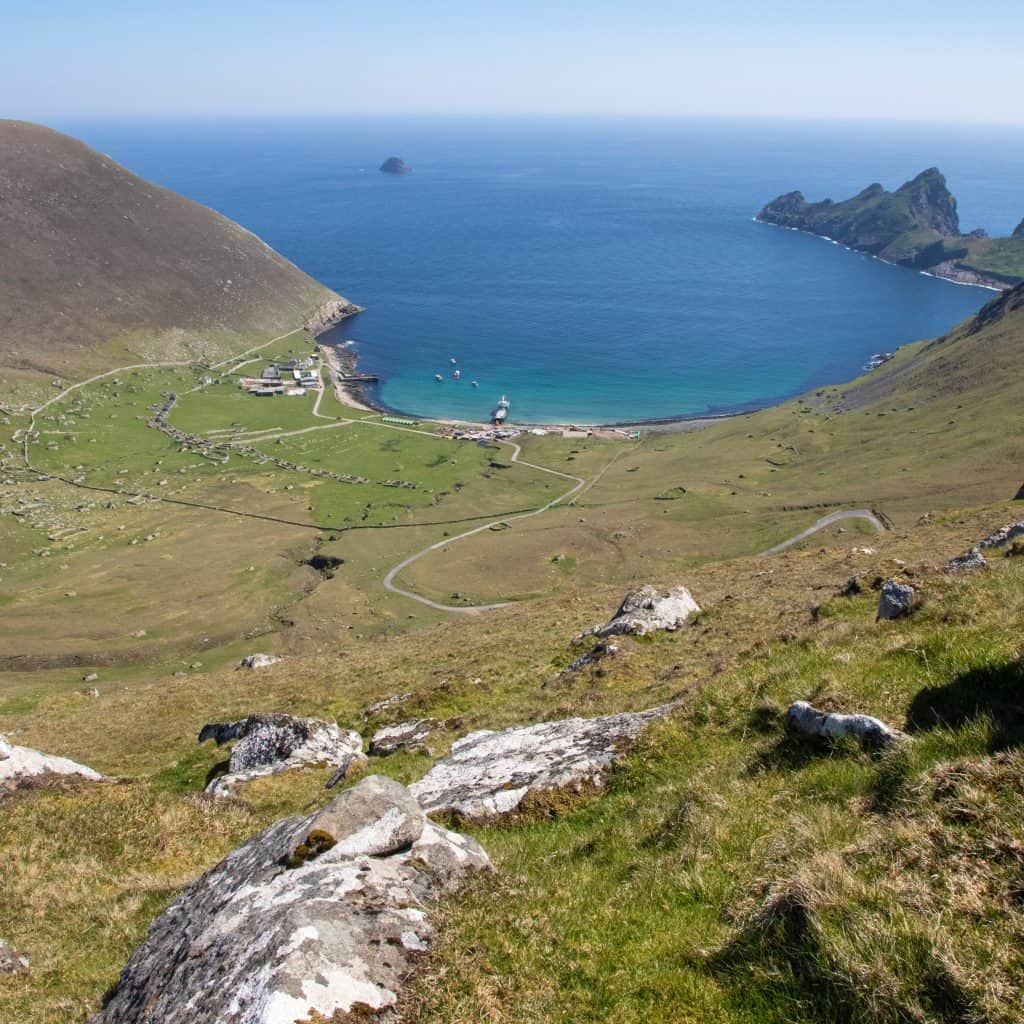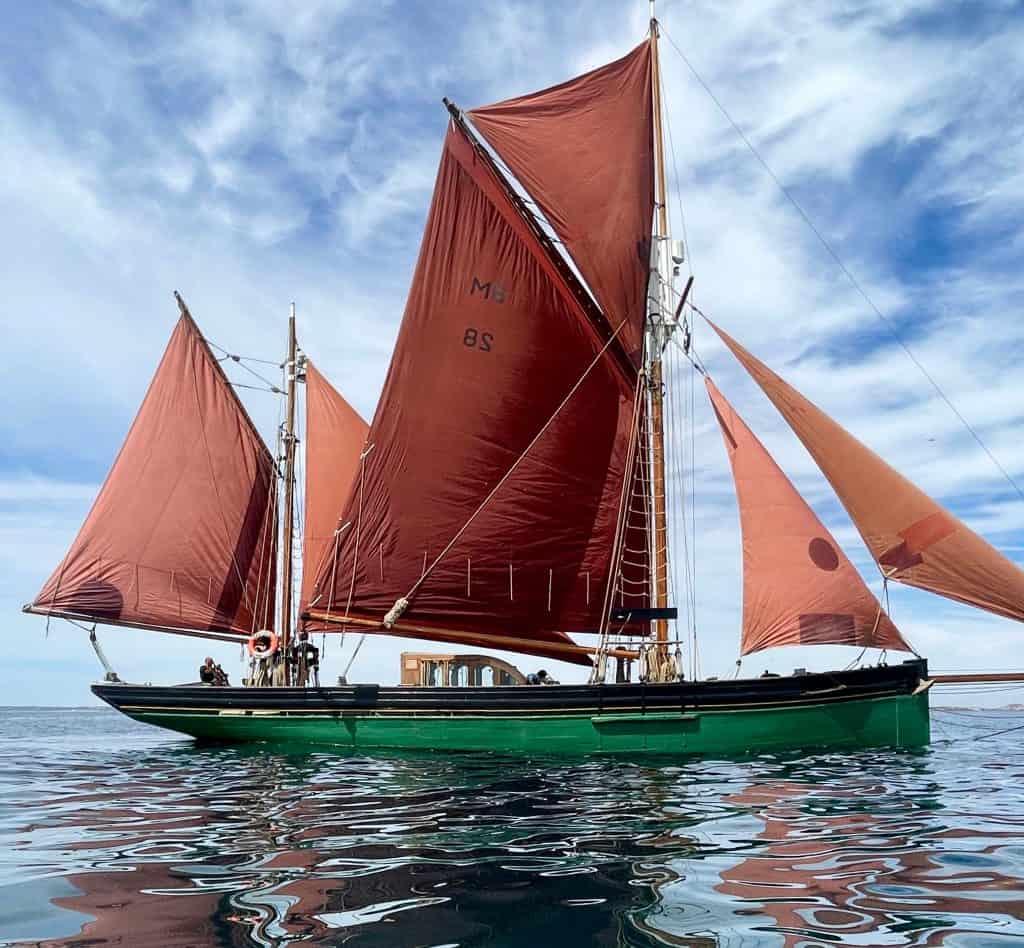| Embark | Disembark | Vessel | Duration | Voyage No |
|---|---|---|---|---|
| Wed 19-06-2024, 14:00Oban, Scotland | Sat 29-06-2024, 10:00Mallaig, Scotland | Provident | 10 Nights | PV190624 |
The Big Midsummer Adventure with St Kilda in mind. St Kilda is a wonderful archipelago of islands and one of Scotland’s remotest treasures. It is a world heritage site 35 nautical miles west of Uist. The main island was inhabited until 1930 and clues to the St Kilda way of life still remain, carefully maintained by the National Trust for Scotland.
Please remember this is an adventure that may or may not include St Kilda.
There is a huge gannet colony and even more puffins.
St Kilda is remote, you can feel the sense of isolation the past inhabitants lived with all their lives.
In midsummer it barely gets dark in June and given clear skies and a soft breeze a night time sail to St Kilda is utterly magical.
Keen to see how people lived in the old days, they weren’t all good. Watch the Gannets as they circle their huge colonies and dive into the cold green sea.
If you are looking for remoteness then you can’t get any further away from the mainland if you tried.

| Vessel type / Rig | Gaff Ketch |
| Guest Berths | 8 |
| Beam | 18ft |
| Draft | 9.2ft |
| Deck Length | 70ft |
| Overall Length | 92ft |
| Tonnage | 85 tons |
| Year Built | 1924 |


Please remember this is an adventure that may or may not include St Kilda.
The unofficial capital of the West Highlands, Oban’s transport links make travel planning nice and straightforward, and there are some glorious landscapes to travel through en route to join the ship. We’d recommend arriving early to explore the town, perhaps visiting McCaig’s Folly with its stunning views across the bay, or nip into the distillery for a bottle to share with your fellow sailors.
Once on board you’ll enjoy a familiarisation from the crew before setting sail. It is only a few miles of open water before you are sailing in the Sound of Mull which has high mountains on either side and mostly flat water.
Your adventure aims to take in St Kilda only if the weather is favourable the beauty of Scotland is that there are so many wonderful places to explore it would be silly to get fixated on St Kilda to the detriment of a great sailing holiday.
Any sailing voyage aiming to reach St Kilda will have to reach the Outer Hebrides first, so you have an island chain of staggering wild beauty to explore en route. These sailing voyages are adventurous expeditions leading to uninhabited islands, sparsely inhabited islands, tiny fishing villages, deep lochs and rugged cliffs that will be appealing to nature lovers and sailors alike.
St Kilda is a wonderful archipelago of islands and one of Scotland’s remotest treasures. It is a world heritage site 35 nautical miles west of Uist. Clues to the St Kilda way of life still remain, carefully maintained by the National Trust for Scotland.
There is a huge gannet colony and even more puffins. St Kilda is remote, you can feel the sense of isolation the past inhabitants lived with all their lives.
Originally settled by humans between four and five thousand years ago, St Kilda’s distance from the rest of the Outer Hebrides allowed for the development of a unique style of self-sufficient island life, that remained much preserved until the archipelago’s eventual abandonment in 1930.
Tens of thousands of birds were caught every year, especially Auks, Northern Fulmars and Northern Gannets. For food they would make dangerous climbing expeditions to catch the birds and their eggs on the incredibly steep cliffs; especially on the island sea stacks of Boreray, Stack and Stack Armin.
One hundred and eighty people lived on the islands towards the end of the 17th century but they only had 16ft boats as transport. There was not enough timber to build their own larger craft so these tiny boats regularly crossed to the Outer Hebrides and on to the mainland – a passage of the eighty miles in an open boat.
In midsummer it barely gets dark in June and given clear skies and a soft breeze a night time sail to St Kilda is utterly magical.
100 year old Provident is a Brixham Sailing Trawler and spent the majority of her working life fishing out of her home port of Brixham. Brixham has been an important fishing port for hundreds of years, and it continues to be so today.
Provident’s story is even older than she is – the Provident you see today is in fact a copy of an earlier trawler of the same name. The original Provident was stuck and sunk by a U Boat in 1915. Today’s Provident was one of the last sailing trawlers to be built (1924). By the mid 1920’s, the heyday of trawling under sail was quickly fading out in favour of more modern motor vessels. In contrast, 50 years prior (in the 1880’s) there were over 3,000 sailing trawlers registered around the UK.
After her life as a sailing trawler came to an end, Provident became a private yacht in America for some years. More recently she was a she returned to Brixham to work as a Sail Training vessel with Trinity Sailing Trust.

Mostly flat seas between the islands with some more exposed dashes or longer sails in open water to St Kilda and to the Outer Hebrides. Expect a real mixture of conditions, as things can change quickly, but the crew are incredibly knowledgeable and familiar with all the sheltered anchorages and hiding places around the islands. The itinerary is kept loose to make the most of the conditions at the time, and the focus is on enjoyment, rather than ticking off any particular destinations.
On a sailing voyage we never use the word itinerary, as skippers will always be aiming for the best and safest sailing routes for the forecast. They are as keen as you to include some of the highlights described above, but when it comes to sailing, you have to go with Mother Nature, not fight her. The description provided is based on what we think might be possible, based on past trips, or prior experience, but nothing is guaranteed on a sailing voyage. As such, the scheduled joining ports, routes, activities and/or destinations may be altered. Due to the complexities of weather systems, this may be at very short notice.
Whether you are an experienced sailor or a complete beginner, the professional crew will train you to be guest crew from the moment you arrive, with the intention that everybody works together to sail the ship. The common thread to all Classic Sailing holidays is ‘Hands on’ participation on ships that use ropes, blocks and tackles and ‘people power’ to set sail. Handling cargo adds an extra dimension – building teamwork and communication skills and leaving you with a great sense of achievement.
We cater for a wide range of ages and physical abilities and how much you are expected to do varies a bit between vessels. See the vessel tab above which explains all about the ‘sailing style’ and what to expect in terms of hands on participation. There is a lot of information about day to day life, the ships facilities and accommodation on the vessel pages.
For joining your vessel in Oban, the North Pier in the map shown below will be the best place to meet the crew. Your vessel will either be tied up alongside the wall, or out at anchor. Make sure you take a note of the ship’s number found in your confirmation in case of any problems on the day.
Oban: Gateway to the Highlands and Isles
Situated on the west coast of Scotland, Oban is a vibrant seaside town known as the “Gateway to the Highlands and Isles.” With its stunning landscapes, rich history, and renowned seafood, Oban offers a captivating blend of natural beauty and cultural heritage that attracts visitors from all over the world.
As you arrive in Oban, you’ll be greeted by the town’s iconic landmark, McCaig’s Tower, perched on a hilltop and offering panoramic views of the surrounding islands and mountains. Explore the charming streets lined with colourful buildings, browse the local shops for unique crafts and souvenirs, and indulge in the freshest seafood at one of the many excellent restaurants.
Oban is the perfect base for exploring the breathtaking Scottish Highlands. Take a scenic drive along the stunning coastal roads, visit the historic castles such as Dunollie Castle and Dunstaffnage Castle, or embark on a hiking adventure in Glen Coe, one of Scotland’s most dramatic and awe-inspiring glens.
Getting to Oban is convenient, with various transportation options available. From Scotland, you can travel by train on the West Highland Line, which offers a picturesque journey from Glasgow to Oban. Sit back, relax, and enjoy the stunning views of lochs, mountains, and charming villages along the way.
If you’re coming from southern England, you can reach Oban by car via the A82 and A85 roads. The drive takes you through breathtaking landscapes, including the enchanting Loch Lomond and the majestic Rannoch Moor.
For those preferring to fly, the nearest airports to Oban are Glasgow Airport and Edinburgh Airport. From there, you can rent a car or take a train to complete your journey to Oban.
By selecting sustainable travel options and actively participating in carbon offset initiatives, you can make a positive impact while journeying to your voyage, where an unforgettable adventure awaits you.
Mallaig: A Captivating Coastal Retreat
Nestled on the picturesque shores of the West Highlands in Scotland, Mallaig is a charming coastal village that offers a delightful escape from the hustle and bustle of city life. With its breathtaking landscapes, rich history, and warm hospitality, Mallaig is an idyllic destination for nature enthusiasts and adventure seekers alike.
As you arrive in Mallaig, you’ll be greeted by stunning vistas of rugged mountains, pristine beaches, and sparkling azure waters. The village itself is a quaint and welcoming place, known for its colourful fishing boats and charming harbour. Take a leisurely stroll along the waterfront, soak in the tranquil atmosphere, and savour the freshest seafood delights at one of the local eateries.
Explore the surrounding area and discover the natural wonders that Mallaig has to offer. Hike through the majestic Glenfinnan Viaduct, famous for its appearance in the Harry Potter films, or embark on a boat trip to the remote and breathtakingly beautiful Knoydart Peninsula. Wildlife enthusiasts will be thrilled to spot seals, dolphins, and a variety of seabirds on their excursions.
Getting to Mallaig is a breeze, with various transportation options available. From Scotland, you can travel by train on the scenic West Highland Line, which connects Mallaig to Glasgow and Fort William. The train journey itself is a treat, offering spectacular views of mountains, lochs, and glens along the way. You can also have some fun on the Hogwarts Express from Fort William to Mallaig, properly known as the Jacobite Steam train.
If you’re coming from southern England, you can reach Mallaig by car via the A82 and A830 roads. The drive takes you through some of Scotland’s most stunning landscapes, including the majestic Loch Lomond and the awe-inspiring Glen Coe.
For those preferring to fly, the nearest airports to Mallaig are Inverness Airport and Glasgow Airport. From there, you can hire a car or take a train to complete your journey to Mallaig.
By selecting sustainable travel options and actively participating in carbon offset initiatives, you can make a positive impact while journeying to your voyage, where an unforgettable adventure awaits you. So pack your bags, get ready to travel and join your adventure in Mallaig.
N.B. BOATS HAVE LIMITED STORAGE SPACE SO PLEASE LIMIT YOURSELF TO ONE SOFT BAG OR RUCKSACK (NOT SUITCASES)
Provident Wild Swimming Adventure PV110924
Embark
Wed 11-09-2024
Oban, Scotland
Disembark
Tue 17-09-2024
Oban, Scotland
From
£1300
Sail Loch Linnhe and explore the Firth of Lorne. 2024: PV240424
Embark
Wed 24-04-2024
Oban, Scotland
Disembark
Mon 29-04-2024
Oban, Scotland
Fully Booked
Explore the Island of Mull 2024: PV010524
Embark
Wed 01-05-2024
Oban, Scotland
Disembark
Tue 07-05-2024
Oban, Scotland
From
£1200
Recently Viewed Voyages
Provident Big Midsummer Adventure PV190624
Embark
Wed 19-06-2024
Oban, Scotland
Disembark
Sat 29-06-2024
Mallaig, Scotland
From
£2000